Posted by Anne M on Friday, Nov 17, 2017
Every morning I drive to the end of Summit to turn onto Kirkwood Avenue and I look at a brick and iron fence with the word “Ardenia.” And every morning, I ask myself, “Why Ardenia?” After several months driving this route, I finally looked it up in "Irving Weber’s Historical Stories about Iowa City." It was a house with an interesting history of its own, but I quickly abandoned that research when I stumbled across the name of Larry Ginter.
You see, Larry (also spelled as Larrie) Ginter is a horse, but not just any horse. Larry Ginter is the type of horse you would name a street after, which Iowa City did (Ginter Avenue). And he wasn’t just a local celebrity—he was known nationally and in Canada, described by a newspaper in Manitoba as “one of the gamest, hard-hearted performers emanating from the Hawkeye State.”
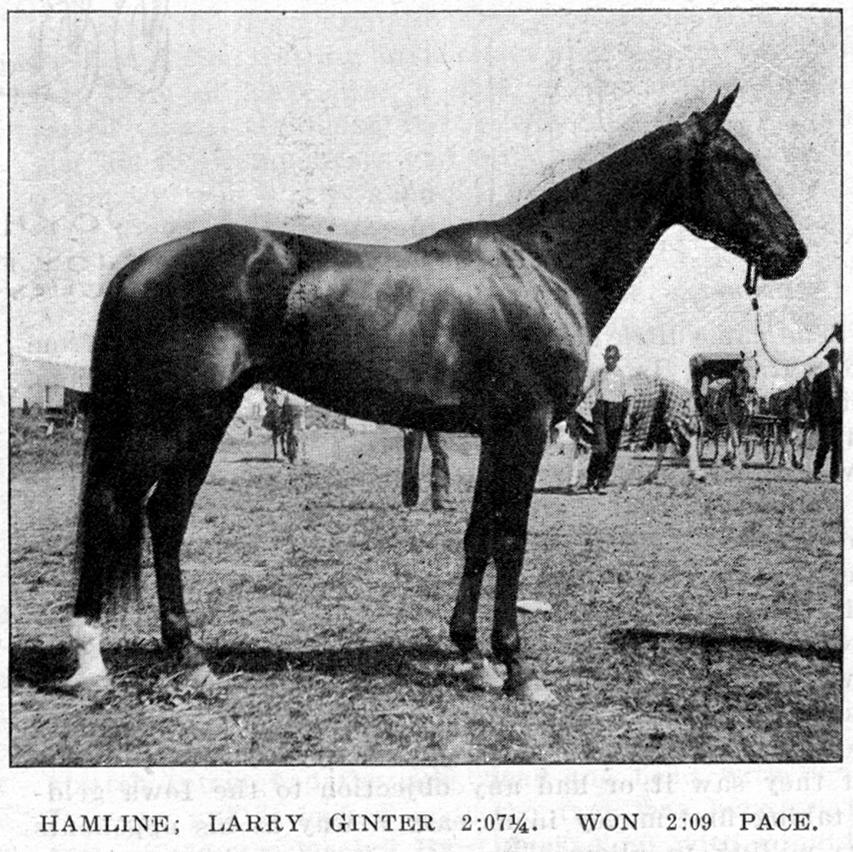
Why is a newspaper in Canada publishing an obituary on a horse from Iowa City? It’s important to know that this was the turn of the century and harness racing was one of the most popular sports in America. Dan Patch, the sport’s king and arguably the most famous sports celebrity of the time, was on everything from cereal boxes to cigars to song books. Races would draw large crowds. Between 25,000 and 30,000 people came out to see if John R. Gentry could beat the 2:00-minute mile mark in 1897 outside of Hartford, Connecticut. He didn’t make the time, but the Edison Manufacturing Co. filmed the race nonetheless. In 1906, 93,000 people watched Dan Patch set the record for a 1:55 mile at the Minnesota Fairgrounds.
Harness racing is the version where the jockey sits in a carriage, called a sulky, and the horse quickly trots around a course. Rather than just running a race, these Standardbreds participate in a series of one-mile heats. Whoever wins the most heats, wins the contest. And Larry Ginter was a contender in races all across the Midwest.
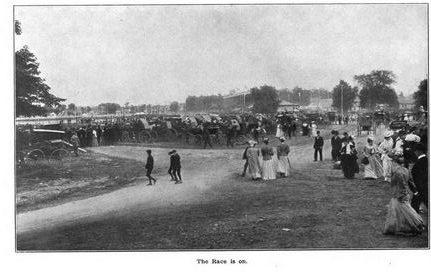
Larry Ginter was foaled in 1893, bred by Col. Edward W. Lucas, son of Robert Lucas, the first Governor of the territory of Iowa. Ginter does have an impressive pedigree, or so says all of the trade journals on harness racing at the time. He was sired by Medeyone (this should cue your oohs and aahs—or it would if this was 1893 and you were a racing fan). Col. Lucas passed away in 1900, so for most of his racing career, Larry Ginter was owned by Lucas’ son, Clark. In the 1901 city directory, C. S. Lucas is listed as a stockraiser residing at 1037 Kirkwood Avenue. The Lucas family owned a small, but reputable stable and constructed the Morningside track to train their horses (the location of it is now Morningside Drive). Lucas took Ginter to West Liberty, Muscatine, and Des Moines for more training.
Larry Ginter’s first race occurred on July 29, 1898 in Davenport. He did okay. Most importantly, he showed promise. He raced around tracks in Iowa winning the first money in six out of ten races ("American Horse Breeder," 8/3/1910). His best time was 2:15 ¼ minutes per mile at Columbus Junction.
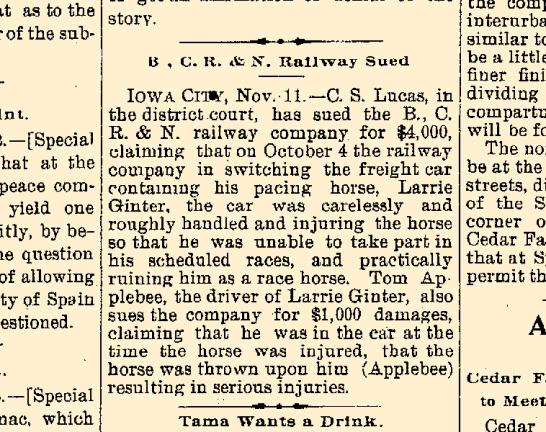
But then there was an accident. On October 4, 1898, Larry Ginter was riding in a train car from Iowa City to Cedar Rapids. While at a switching yard in Cedar Rapids, the freight car holding Larry “collided into the engine,” throwing the stallion against the side of the car and injuring him ("Cedar Rapids Evening Gazette,"11/12/1898). Lucas complained that the railroad employees “carelessly and roughly handled” the freight car ("Waterloo Daily Reporter," 11/12/1898). On November 11th, C.S. Lucas sued the Burlington, Cedar Rapids and Northern Railway for $4,000 for the horse’s injuries, citing losses from the horse’s inability to race the rest of the season. Lucas also asked for another $1,000 for the injuries to Tom Applebaum, Larry’s trainer, who had the horse fall on him during the freight switch. In the suit, Lucas indicated that there was a fear that Larry would never race again.
If for one fleeting moment you thought that this accident was the last of Larry Ginter, you don’t know Larry Ginter. On August 8th, 1901, Larry Ginter reappeared at the starting line in Freeport, Illinois. He was a better horse, bringing his time down to 2:11 ¼. This was the beginning of something wonderful—Larry Ginter starts pacing fast:
In 1902, his best race was at Freeport on July 30th running 2:08 ¾
In 1903, his best race was at Davenport on August 15th running 2:07 ¼
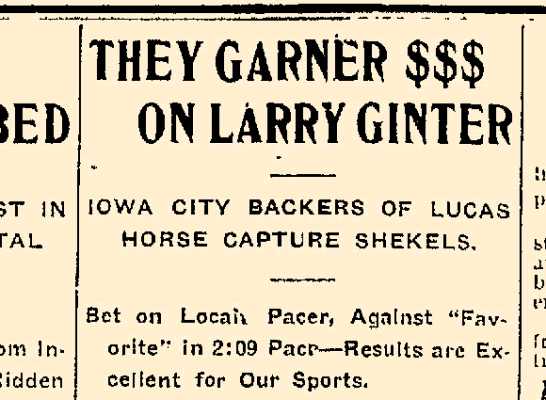
In 1904, his best race was at Columbus, Ohio on September 19th running 2:06 ¾
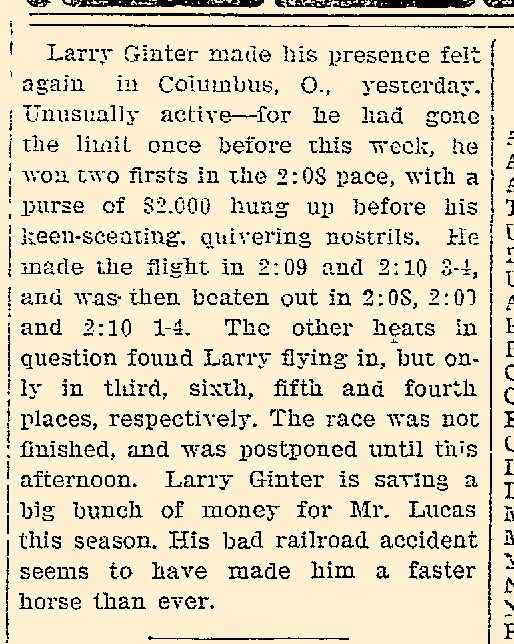
In 1906, his best race and personal record was at Milwaukee, Wisconsin on September 11th running 2:06 ½
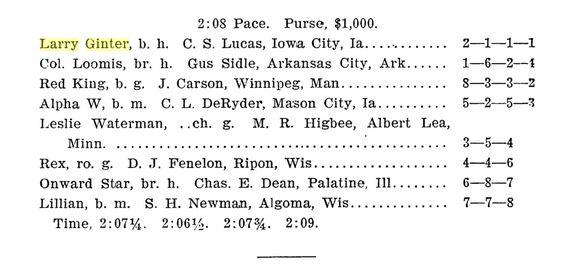
He retired in 1907. "American Horse Breeder" (8/3/1910) states “Larrie Ginter was campaigned for eight seasons. He was started in all 61 races, won first money in 26 of them, second money in 15, third money in five, fourth money in six races, and failed to get any part of the money in nine.” Or as the "Iowa City Daily Press" (9/20/1904) colorfully puts it, Larry Ginter was an "Iowa City streak of lightening in the shape of a horse." In that Canadian newspaper, the "Miniota Herald," they quote C.S. Lucas on Larry’s retirement, “He’s through now for all time; he’s been awfully good to me and it’s a whole lot of satisfaction to know that while I have raced him hard, met all sorts of company, some with more speed than I had, he has come home each year with a few dollars earned and as he stands today he doesn’t owe me a cent and will end his days right where is in his birthplace.” Larry Ginter spent his final days back at the Lucas Farm in Iowa City. He died in the summer of 1910.
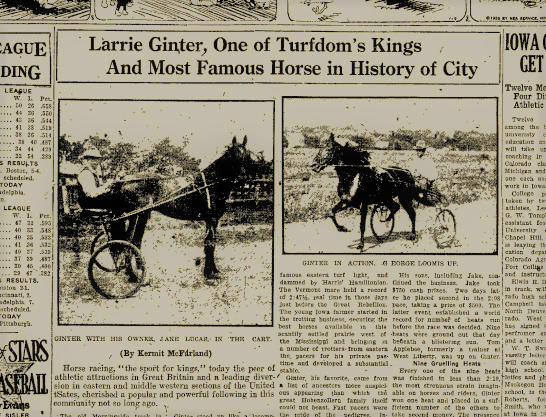
A note on the accident of 1898: If the accident didn’t create a long term effect on Larry, it did on the liability of Iowa railroads with freight. C.S. Lucas won his lawsuit against the B., C. R. & N. Railway Company and awarded $2,500. The railroad appealed the case, successfully getting their responsibility down to $1,800, but they appealed that as well. The lawyers for the Burlington, Cedar Rapids, & Northern Railway argued that the plaintiff committed fraud and therefore the liability of the railroad was forfeited. When the horse was shipped, Lucas did not tell the railroad it was a stallion of worth, so the railroad agents believed it was a “common horse.” Perhaps Lucas did not disclose that it was a stallion to receive a cheaper rate in shipment costs. Because the worth of the horse was not disclosed, the railroad was only responsible for the $100, the value of a regular horse. The railway’s argument did not hold water with the Iowa Supreme Court. They ruled on December 22, 1900 that the original verdict and award was affirmed and the B., C. R. & N. Railway Company was liable.
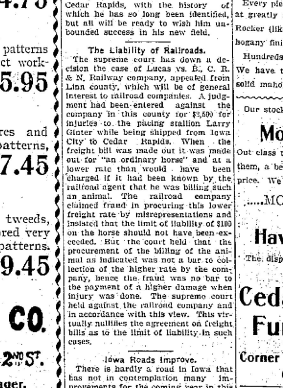
Larry Ginter Facts
- He was a pacer—not a trotter. There is an important difference.
- He stood at 15 ¼ hands and weighed about 1,000 pounds.
- He lived for 17 years.
- He was driven by Charles Kenyon, Bob Bell, Bert Bigbee, W.O. Foot, George Loomis, Harry Bush, and J.S. Potter (to name a few).
I was curious as to why name the horse Larry Ginter? Lucas did not follow the convention at the time, which took part of the name of the sire and dam. Perhaps a clue is where Lucas brought Larry for race training. According to a 1926 article in the "Iowa City Press Citizen," Lucas also liked a track in Sedalia, Missouri. While researching this post, I kept running across another Larry Ginter, the owner of Edge Brook Farm in…Sedalia. He was a contemporary of C.S. Lucas, also racing horses in the same harness circuits. An homage to a friend or were they bitter rivals?
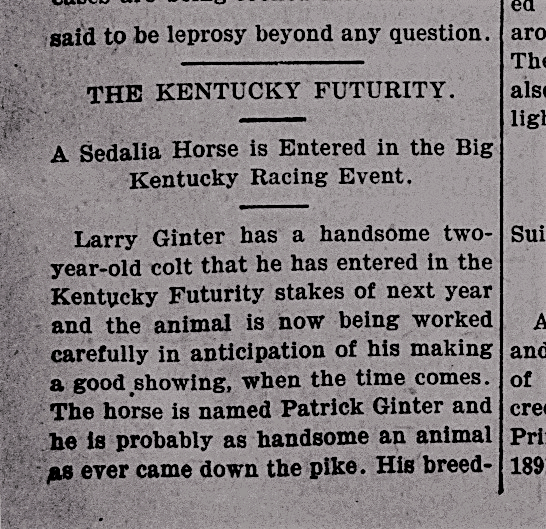
How did I get from Ardenia to Larry Ginter? Col. Edward W. Lucas built a house in 1855 on the site of where that fence sits. The property is not far from the other Lucas family house of Plum Grove. In 1925, the Lucas family sold the property to Albert Burkley (owner of the Burkley Hotel), who attached a stone façade to make the house look like an English castle. He called the house Ardenia. In 1990, it was demolished.
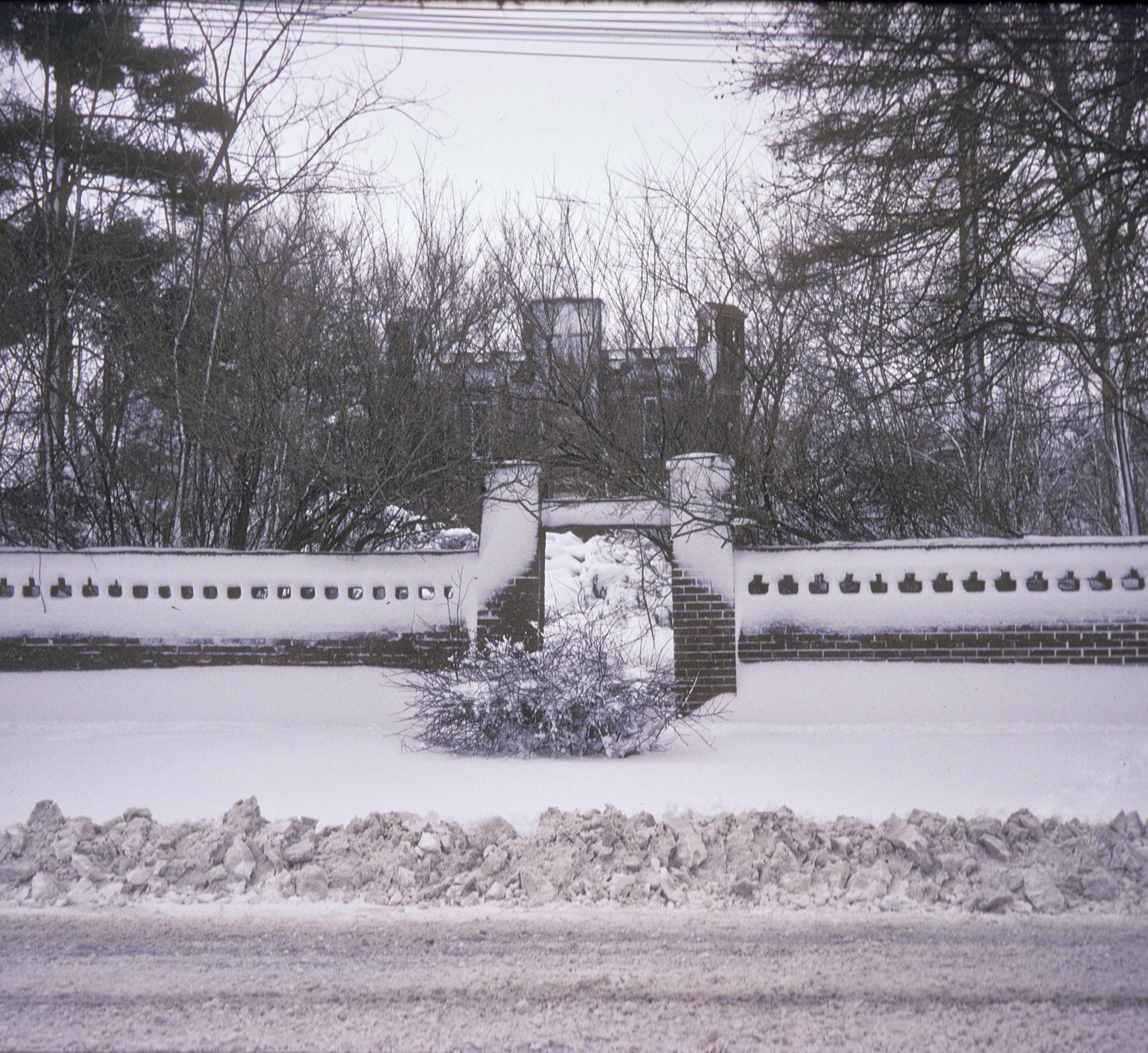
Always had a question about Iowa City history? The Iowa City Public Library has a number of fantastic resources to help you find the answer. From the Digital History Project where we collect historical images, documents, and video to the Local News Index, our resource to make finding articles our collection of local newspapers on microfilm easier. We also have access to Newspaper Archives, more recent issues of the "Press-Citizen" through Proquest, Irving Weber’s Iowa City, and the Historical New York Times. We have city directories dating back to the early 1900’s and a full run of our local newspapers on microfilm. And if we don’t have it, we can try our luck with other libraries and borrow materials through interlibrary loan.
Sources:
“Announcements.” (1903, Sept 11). Iowa State Press. Retrieved from Newspaper Archive via the Iowa City Public Library.
Annual Report of the Wisconsin State Board of Agriculture for the year of 1907. Originally published: Madison: Democrat Printing Company, State Printer, 1907. Retrieved from Google Books.
“Back Money for Ginter.” (1906, Jan 26). Iowa Citizen. Retrieved from Newspaper Archive via the Iowa City Public Library.
“B, C.R. & N. Railway Sued.” (1898, Nov 11). Waterloo Daily Reporter. Retrieved from Newspaper Archive via the Iowa City Public Library.
Beers, Johanna Nelson. “Have you heard?” (1955, Apr 4). Iowa City Press Citizen. Retrieved from Newspaper Archive via the Iowa City Public Library.
City Directory of Iowa City, 1901-1902. Chicago: R.L. Polk, Co., 1901.
“C.S. Lucas v. The Burlington Cedar Rapids & Northern Railway Company, Appellant.” Reports on the Cases in Law and Equity Determined in the Supreme Court of the State of Iowa. v.12. Originally published: Des Moines: Geo. H. Ragsdale, 1901. Retrieved from Google Books.
“District Court will open next Monday.” (1898, Nov 12). Cedar Rapids Evening Gazette. Retrieved from The Gazette Digital Archives via the Cedar Rapids Public Library.
“Free for all pace.” (1905, Aug 4). Waterloo Daily Reporter. Retrieved from Newspaper Archive via the Iowa City Public Library.
Hibbs, Bob. “Saturday postcard: The Burkley home, Ardenia.” (2003, Aug 23). Press - Citizen Retrieved from Proquest via the Iowa City Public Library.
“Horses at Columbus Junction.” (1902, June 10). The Horse Review. Chicago: J.C. Bauer, 1902. Retrieved from Google Books.
“Johnson County Fair: Good Speed Program Arranged for Iowa City.” (1898, Sept. 12). Cedar Rapids Evening Gazette. Retrieved from The Gazette Digital Archives via the Cedar Rapids Public Library.
“Kentucky Futurity.” (1900, July 5). Sedalia Weekly Standard. Retrieved from Newspaper Archive via the Iowa City Public Library.
“Larrie Ginter.” (1910, Aug 3). American Horse Breeder. Boston: American Horse Breeder. p. 676. Courtesy of the Harness Racing Museum and Hall of Fame.
“Larrie Ginter wins the pace.” (1905, Aug 4). Waterloo Daily Courier. Retrieved from Newspaper Archive via the Iowa City Public Library.
“Larry Ginter.” (1903, Sept 8). The Horse Review. Chicago, Illinois: Horse Review, 1903. p. 1035. Courtesy of the Harness Racing Museum and Hall of Fame.
“Larry Ginter.” (1904, Sept. 20) Iowa City Daily Press. Retrieved from Newspaper Archive via the Iowa City Public Library.
“Larry Ginter.” (1904, Sept. 23) Iowa City Daily Press. Retrieved from Newspaper Archive via the Iowa City Public Library.
“Larry Ginter.” (1910, Sept. 8). Miniota Herald. Retrieved from Newspaper Archive via the Iowa City Public Library.
“Liability of Railroads.” (1900, Dec 27). Cedar Rapids Republican. Retrieved from The Gazette Digital Archives via the Cedar Rapids Public Library.
“Major Delmar Failed.” (1904, Sept 23). The New York Times. Retrieved from the Historical New York Times via the Iowa City Public Library.
McFarland, Kermit. “Larrie Ginter, One of Turfdom’s Kings and Most Famous Horse in History of City.” (1926, July 8). Iowa City Press Citizen. Retrieved from Newspaper Archive via the Iowa City Public Library.
“They Garner $$$ on Larry Ginter.” (1903, Aug 17). Daily Iowa State Press. Retrieved from Newspaper Archive via the Iowa City Public Library.
“Travel in Fast Company.” (1903, Aug 9). Iowa Citizen. Retrieved from Newspaper Archive via the Iowa City Public Library.
Weber, Irving. Historical Stories about Iowa City. v. 1. Originally published: Iowa City: Lions Club, 1976. Retrieved from University of Iowa Digital Library.


This incredible work of nonfiction reads like a fast-past melodrama. -Anne M